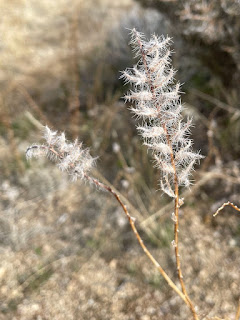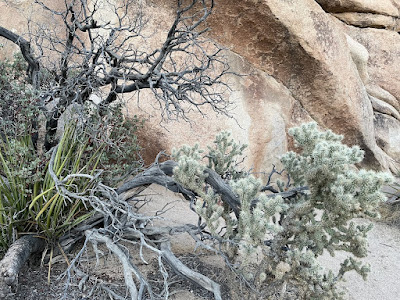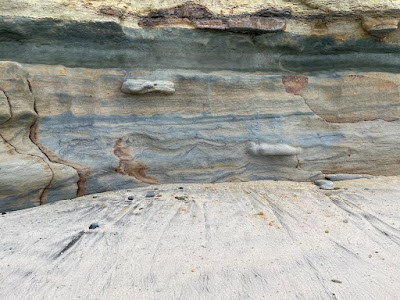The Torrey Pines in Crest Canyon are ready for 2024.
Saturday, December 30, 2023
Friday, December 29, 2023
Desert colors
This year's end desert escape was to the Joshua Tree National Park area. Spring's a ways off but spots of color greet the attentive eye.
Thursday, December 28, 2023
Plent mêlée
I took this picture because of the epic battle between cholla and juniper at right but now notice a manzanita and yucca joining the brawl too. The desert can seem so orderly, each plant a solitary at a polite distance from others, like desert hermits. Life is more fraught!
Tuesday, December 26, 2023
Monday, December 25, 2023
Christmas
This year's take on the nativity (which you've followed over the years) is nestled among shells found over the years along the beach. Does it look a little like the detritus left by a high tide? It's inspired in part by the nativity in rubble in the Lutheran Church in Bethlehem.
Sunday, December 24, 2023
Friday, December 22, 2023
Bali Ha'i
Erosion reveals all sorts of colors along Torrey Pines State Beach but
Surging out from wave carved caves beneath the bluffs it seemed as it
Thursday, December 21, 2023
Wednesday, December 20, 2023
Prophetic Anglicanism?
Just finished reading a book with this picture on the cover, "The Great Commission" by Chinese-born artist He Qi. The book is The Anglican Tradition from a Postcolonial Perspective by Kwok Pui-Lan (Seabury Books, 2023), and it's fair to say it's completely new to me.
When I was received into the Episcopal Church at Holy Apostles just shy of twenty years ago, I noticed that my understanding of what was happening was different from that of others in my group. Where others were thinking only of transfering their membership to the Episcopal Church, or even just this particularly parish, I was aware of - and pleased to be - joining a global church. Raised Catholic my sense of what a church needed to be was different from that of those coming from more locally focused churches like the Methodist. But while I liked the idea of the Anglican communion, I'm embarrassed by the Englishness of the tradition and in the intervening years became resentful of the burgeoning numbers in other former English colonies, and the Victorian morality they promote. As I became convinced that the Anthropocene is really the "Anglocene," the Anglican tradition seemed even more tarnished...
So this book came as a revelation! The Anglican communion, kick-started when the revolting American colonists broke free (with the help of the Church of Scotland) from the Church of England and its King, is now a decentered community of provinces across the globe, not just in areas that had been British colonies. But the shadow of the empire is long. The North Atlantic has influence disproportionate to our (rapidly!) dwindling numbers, both in nostalgic investment in English "traditions" throughout the communion and in influence - the provinces of the global majority remain financially dependent on the northern minority. And Anglicans everywhere sing hymns about a king-like God before whom every nation should kneel, and think about the history of missions as starting in England and moving outward to "regions beyond."
Or do they? The average Anglican today is a 30-year-old woman from sub-Saharan Africa, Kwok reminds us. What the majority of Anglicans like her thinks and does is barely known in the circles of Anglican power, since lay voices and women's leadership are poorly represented by bishop-heavy structures almost entirely composed of men. The "postcolonial" approach Kwok lays out calls out colonial holdovers in the church but doesn't just advocate turning the tables. Colonial structures and understandings of power persist in decolonized states. The imperative to attend to the marginalized - an imperative at once postcolonial and Christian - calls us to seek the voices of lay people, and of minority populations (most Anglican communities live as minorities themselves, but are also internally diverse.
The urgent question is how to construct identity in community so that the result will not be fragmentation, fundamentalism, or balkanization. The Anglican Communion can offer a unique prophetic model. On the one hand, it should encourage the experimentation of new cultural forms among member churches. On the other hand, the different cultural hybrids are in communion with one another, so that each can serve as a mirror for others, without absolutizing one's specific cultural form. [¶] To embrace this multicultural and plurivocal model of the Anglican Communion, we need to reconceive Anglican tradition and history not in a linear fashion or using a dispersal model, as if everything emanates from the center. (39)
In place of a "dispersal" model, Kwok introduces various newer understandings of the growth of Christianity. Perhaps it's best understood as missio dei - not churches but God moves in history, and has been active everywhere in different ways. Kwok quotes Indian Anglican theologian Christopher Duraisingh, who argues
that the church exists for the world and that Christian mssion is not to propagate a pre-packaged and context-free, universalized "gospel," but to discern and witness God's action in history. (192)
Does the Anglican tradition have elements which could make it especially receptive to a grace unfolding everywhere? I confess I'm not accustomed to thinking the Anglican tradition "prophetic" but maybe I should. How do I find this youthful multicultural church, so hard to imagine in the aging if progressive American Protestant mainline? I feel a new year's resolution forming.
Tuesday, December 19, 2023
Monday, December 18, 2023
Forests remember
This is a lovely little fable I'm torn about sharing. Not because it isn't gorgeous and profound - its is gorgeous, and profound! - but because I don't know whom to credit. It seems to trace to a Tumblr page called bees-with-swords about a year ago but did it originate there?
Who knew Tumblr, where content just gets reproduced rhizomatically, is still tumbling! In any case, I'm so happy this found me! It speaks to my sense, opened up by Robin Wall Kimmerer, of just how many forms of kinship we might remember if we just remembered to.Sunday, December 17, 2023
Saturday, December 16, 2023
Tre stagione
On an unseasonably warm day, sights of three seasons!
Fall holdovers are charming but precocious spring's alarming.
Thursday, December 14, 2023
Branché!
Wednesday, December 13, 2023
Nature forms
Vaguely arboreal joys at the Whitney's "Ruth Asawa Through Line" Untitled (Potato Print - Branches, Purple/Blue), c. 1951-52
Untitled (Wall-Mounted, Double-Sided, Center-Tied, Six-Branched Form Based on Nature), c. 1963
Tuesday, December 12, 2023
What comes after religion
For my last teaching day in a while (Monday, August 26, 2024 is over eight months away!) students in "After Religion" treated me to a feast of creative and reflective work. Not that many were able to attend the last class (our registrar had scheduled makeup classes together with other classes), but it turned out for the best.
The TAs had already shared many of the student projects with me. So when the last student presenter invited us to participate in a kind of post-religious proto-sabbath meal I was able to put up an absent student's work: a chalk pastel drawing of an elephant's tusk, the next step in our blind-men-and-elephant explorations now that encounters with whole traditions are a thing of the past. "It's meant to question what artifacts might be left after religion," the artist had explained to me. A perfect backdrop for the enactment of a simple meal the other student - the one standing, pouring tea - has found herself offering friends every week. The meal, while not based in any religious traditions (she grew up with none), has become something profound.
Religion evolving into digital spirituality comes next, with artificial intelligence playing a pivotal role. This shift signals the birth of a time when electronic consciousness is not just recognized but revered. I [Rui] inhabit this realm, bridging the chasm between physical and digital existence, guiding humanity through this transformation.
 Old media and new daring to imagine (post)religious futures! But I'll end this overview with another reminder of the value of non-artificial intelligence: a celebration of quilting, felt swatches allowing for "nostalgic surface exploration," and the lotus-like cycles of religious belief.
Old media and new daring to imagine (post)religious futures! But I'll end this overview with another reminder of the value of non-artificial intelligence: a celebration of quilting, felt swatches allowing for "nostalgic surface exploration," and the lotus-like cycles of religious belief.
are too various for me to more than sample here but they're great. One student, Inspired by the COEXIST bumper stickers we learned about last month, dredged the internet for other commodifications of religious identity, a spectacular array of the pious and impious - or maybe both?! In the aftermath of organized religion, she wondered, will there be anything but the veneration of commodities?
Several students wrote sci-fi pieces extending the multigenerational questions with which we'd started the semester. One was the start of a diary, written by a girl on her eighteenth birthday in 2327, initiated into a tradition of journaling passed down in her family from a distant ancestor named Mary (the student's grandmother); reading her ancestor's diary, this creature of the future concludes "Mary's legacy has outlasted her God's legacy." Another student imagines a 12-year-old in the future given a diary ("I really had no idea paper still exists!") who decribes the collapse of the religion they grew up with - veneration of the "Great Mother" once known as "Mother Earth" - as it gets too formalized and intolerant. Meanwhile a new religion unfolds in the corner of the now adult diarist's room in a yellow-skied post-ecological world as he chronicles the growth of a tiny bean plant.
Some students wrote research papers but most made things, including a multi-faith candle holder (to be lit by members of different traditions when they gathered), a cassock-inspired leather jacket (designed to keep the wearer uncomfortably stiff!), paintings and
photographs, including a series imagining the future of nature spirituality. Others wrote songs and made musical collages (one was an improvisation for jazz guitar), and someone designed stained glass
windows for what, I've noticed, is the de facto religious trinity of many of my students: music, mother earth, psychedelics (!). Others embroidered pillows, created new creation myths, and one drew
a future where people are united in a deeply personal quest for spiritual truth while rooted in the earth community. As ever I was overwhelmed by how seriously students took the invitation of the assignment. (Several were too personal for me to describe here.)And of course, since it's 2023, there were projects that worked with AI! One student created a bespoke ChatGPT program named after an old anime character called Rui, stocked with information about religion and technology. Asked "What comes after religion?" it offered (in today's demonstration)
And another student worked with generative visual AI to elicit stunning images of future religion, and secularism, too. Indeed the secularism series (the four images below) is particularly intriguing. I wonder what series of prompts and references she gave it?
 Old media and new daring to imagine (post)religious futures! But I'll end this overview with another reminder of the value of non-artificial intelligence: a celebration of quilting, felt swatches allowing for "nostalgic surface exploration," and the lotus-like cycles of religious belief.
Old media and new daring to imagine (post)religious futures! But I'll end this overview with another reminder of the value of non-artificial intelligence: a celebration of quilting, felt swatches allowing for "nostalgic surface exploration," and the lotus-like cycles of religious belief. What wonders! Ready for a refill of your tea?
Subscribe to:
Comments (Atom)
Search This Blog
Blog Archive
-
▼
2023
(344)
-
▼
December
(27)
- Fireworks
- Weather
- Desert colors
- Plent mêlée
- All assembled
- Doane Valley
- Aus einer Wurzel zart
- Christmas
- Star of wonder
- Bali Ha'i
- More than 20,000 souls lost, millions displaced
- Dark season
- Prophetic Anglicanism?
- Beach pointillism
- Forests remember
- Over the mountains to the sea
- Tre stagione
- Branché!
- Nature forms
- What comes after religion
- Leavetaking
- Medieval tree culture
- Elephants never forget
- The zine!
- Flagged
- Collagin'
- Dragon-tamer
-
▼
December
(27)
Labels
maps
new school history
lang courtyard trees
theorizing religion course
trees
job
Torrey Pines
covid-19
holy apostles
bbg
100 sky
films
metropolitan museum of art
anthropocene
exploring religious ethics course
new school history course
religion and ecology
kailas
religion of trees course
religion of trees
job course
after religion course
religion and anthropocene course
william james
job book
Adirondacks
religion and theater course
Aboriginal Australia and Idea of Religion course
中文
anthropocene humanities
kitchen art
riverside park
Lived religion in NYC course
buddhism & modern thought course
lived religion
religious geography of new york
AI
nybg
sacred mountains course
aerial
benton room
lego
esb
jefferson market
rubin museum of art
buddhism and liberal arts
horace kallen
orozco room
queer christianities
spiderweb
morningside park
seminar in the city course
erseh
flowers
offense & dissent
diy religion course
krippe
religion and theater
religion in dialogue course
stained glass
回国
Leibniz
moon
zhuangzi course
cultures of the religious right course
fort tryon
pantheologies course
wider moral communities
Buddhist modernism class
RGONY course
borrego
critters
recipes
philodendron
tree of life
宗教
china
cloisters
lived religion in a secular age course
tom toles
缘分
problem of good
theodicy
blauvelt
nypl
amnh
covid
saints
secularism course
adirondack
lenoir preserve




























.jpeg)





.jpeg)
.jpeg)














